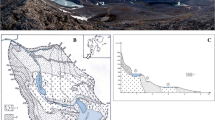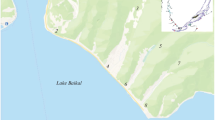Abstract
The seasonal features of the water chemistry in the saline shallow lakes Laguna de Manjavacas and Laguna del Pueblo (Castilla – La Mancha, Central Spain) were studied during 1990–1991 and in 1997. These lakes were both affected by sewage inputs driving them to a high trophic status. However, whereas sewage inputs entered Laguna del Pueblo directly, wastewater reached Laguna de Manjavacas after running for 8 km through a small riverbed, where natural processes caused partial mineralisation of organic matter. Moreover, water quality was further improved before entering the main water body of Laguna de Manjavacas, since water crossed through a wetland and high amounts of organic matter and inorganic nutrients were retained there. Anyway, in both lakes spatial heterogeneity was mainly associated with the distance to sewage inputs, and this was also reflected by the sediment chemistry. The patterns of water evaporation and precipitation-dissolution of salts strongly determined the salinity of their waters. During the warmest period (which coincided with the main drought period) water losses by evaporation increased water salinity, whereas a higher dilution was found during the cold rainy period. However, the relatively higher amount of low-salinity sewage inputs in Laguna del Pueblo allowed this lake to maintain its hyposaline characteristics. In contrast, Laguna de Manjavacas shifts from hyposaline to hypersaline following the seasonal cycle with different rain and temperature regimes, as the relative importance of the permanent wastewater inputs was lower here than in Laguna del Pueblo. Inorganic nutrient dynamics was determined in both lakes both by the sewage supply and by consumption by phytoplankton, with soluble P depletion following algal blooms.
Similar content being viewed by others
References
Alcorlo, P., A. Baltanás & C. Montes, 1996. Is it possible to predict the salinity of Iberian salt lakes from their conductivity? Hydrobiologia 330: 137–142.
APHA, AWWA,WEF, 1992. Standard Methods for the Examination of Water and Wastewater. 18th edition. American Public Health Association. Washington D.C.: 1100 pp. Armengol, X., I. García-Ferrer, M. A. Rodrigo, A. Camacho, M. J. Dasí, M. R. Miracle & E. Vicente,. Seasonal and spatial heterogeneity in the plankton communities of two saline water bodies from La Mancha (central Spain). (in preparation).
Baltanás, A., C. Montes & P. Martino, 1990. Distribution patterns of ostracods in Iberian saline lakes. Influence of ecological factors. Hydrobiologia 197: 207–220.
Camacho, A. & R. de Wit, 2003. Effect of nitrogen and phosphorus additions on a benthic microbial mat from a hypersaline lake. Aquat. Microb. Ecol. 32: 261–273.
Camacho, A., M. R. Miracle & E. Vicente, 2003. Which factors determine the abundance and distribution of picocyanobacteria in inland waters? A comparison among different types of lakes and ponds. Arch. Hydrobiol. 157: 321–328.
Cirujano, S., 1980. Las lagunas manchegas y su vegetación. Anales del Jardin Botánico de Madrid 37: 155–191.
Cirujano, S., 1995. Flora y vegetación de las lagunas y humedales de la provincia de Cuenca. Junta de Comunidades de Castilla La Mancha-Real Jardín Botánico CSIC: 224 pp.
De La Peña, J. A., 1987. Las lagunas de La Mancha: un ejemplo de sales en ambiente continental. In RACEFN (ed.), Bases Científicas Para la Protección de los Humedales en España. Real Academia de Ciencias Exactas, Físicas y Naturales (RACEFN). Madrid: 79–93.
Díaz, P., M. C. Guerrero, P. Alcorlo, A. Baltanás, M. Florín & C. Montes, 1998. Anthropogenic perturbations to the trophic structure in a permanent hypersaline shallow lake: La Salada de Chiprana (north-eastern Spain). Int. J. Salt Lake Res. 7: 187–210.
García-Ferrer, I. 2001. Hidroquímica y estudio del estado trófico de las lagunas endorreicas manchegas de la cuenca del río Záncara. Ph. D. Thesis. Universidad de Valencia: 388 pp.
Golterman, H. L., R. S. Clymo & M. A. M. Ohnstad, 1978. Methods for physical analysis of fresh waters. Blackwell Scientific Publications. Oxford. London. Melbourne: 213 pp.
Greenwald, G. M. & S.H. Hurlbert, 1993. Microcosm analysis of salinity effects on coastal lagoon plankton assemblages. Hydrobiologia 267: 307–335.
Hammer, U. T., 1981. Primary production in saline lakes. Hydrobiologia 81: 47–57.
Hammer, U. T., 1986. Saline lake ecosystems of the world. Monographie Biologicae, Vol. 59. Dr. Junk Publ: 616 pp.
Javor, B., 1989. Hypersaline Environments. Springer-Verlag. Berlin: 328 pp.
Kesepeczki, É, D. Gól, P. Szabó & F. Pekár, 2003. Preliminary investigatons on nutrient removal efficiency of a wetland-type ecosystem. Hydrobiologia 506–509: 665–670.
LaLiberté, G. & J. De La Noüe, 1993. Auto-, hetero-, and mixotrophic growth of Chlamydomonas humicola (Chlorophyceae) on acetate. J. Phycol. 29: 612–620.
Margalef, R., 1947. Estudios sobre la vida en las aguas continentales de la región manchega. Publicaciones Institudo de Biologia Aplicada 4: 5–51.
Martino, P., 1988. Limnología de las lagunas salinas españolas. Universidad Autónoma de Madrid: 264 pp.
OECD, 1982. Eutrophication of waters. Monitoring, assessment and control. OECD, Paris: 154 pp.
Ordoñez, S., M. A. García del Cura, F. Mingarro & M. C. López de Azcona, 1987. Mineralogénesis de sales sulfatadascloruradas magnésicas en la Laguna de Alcahozo (La Mancha-Ciudad Real). Boletin de la Sociedad Española Mineralogia 10: 219–229.
Plans, P., 1969. Problemas del endorreismo español. Revista Academia de Ciencias de Madrid 63: 271–309.
Søndergaard, M., J. P. Jensen & E. Jeppesen, 2003. Role of sediment in internal loading of phosphorus in shallwo lakes. Hydrobiologia 506–509: 135–145.
Sundareshwar, P. V. & J. T. Morris, 1999. Phosphorus sorption characteristics of intertidal marsh sediments along an estuarine salinity gradient. Limnol. Oceanogr. 44: 1693–1701.
Wood R. B. & J. F. Talling, 1988. Chemical and algal relationships in a salinity series of Ethiopian inland waters. Hydrobiologia 158: 29–67.
Author information
Authors and Affiliations
Rights and permissions
About this article
Cite this article
García-Ferrer, I., Camacho, A., Armengol, X. et al. Seasonal and spatial heterogeneity in the water chemistry of two sewage-affected saline shallow lakes from central Spain. Hydrobiologia 506, 101–110 (2003). https://doi.org/10.1023/B:HYDR.0000008593.32525.1d
Issue Date:
DOI: https://doi.org/10.1023/B:HYDR.0000008593.32525.1d




